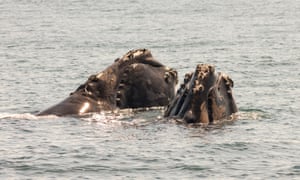Even slow-moving boats likely to kill endangered right whales in a collision, study finds
Canadian government’s speed restrictions are not enough to prevent deaths of endangered animals, researchers say
 |
There are only 356 North Atlantic right whales remaining, according to estimates. Photograph: Don Emmert/AFP/Getty Images
Thu 24 Dec 2020
For North Atlantic right whales, collisions with large cargo vessels are one of the deadliest threats to an endangered population. But new research from Canada has found even under the government’s current maritime speed restrictions, strikes are likely to be fatal.
In a new paper published in Marine Mammal Science, biologists found that collisions between large vessels and whales at a speed of just 10 knots had an 80% chance of producing a fatality.
“Speed restrictions do reduce the probability of lethality if a vessel strike occurs, but they’re just not doing it enough. We need to be cautious in thinking that we’ve solved the problem when the reality is that we haven’t,” said the study’s lead author, Sean Brillant, a conservation biologist for the Canadian Wildlife Federation and adjunct professor at Dalhousie University in Halifax.
According to estimates, only 356 North Atlantic right whales remain. Most of their deaths are caused by human action.
In recent years, the Canadian government has taken steps to reduce whale fatalities, including limiting the speed of large ships and closing commercial fishing areas where the whales are often spotted.
In addition to demonstrating that collisions are often fatal at relatively slow speeds, Brillant and his team were surprised to find that smaller vessels like lobster boats still had a chance of killing whales if the two collided.
 |
“If you put two objects of similar sizes and one of them is soft and squishy and the other one doesn’t break form when it collides with something, the chances of a serious injury are pretty good,” said Brillant.
The government’s transportation agency, Transport Canada, and commercial fishermen have been interested in the findings, said Brillant. Transport Canada requires that smaller ships – those more than 13 meters long – reduce speeds, probably reflecting the new information.
While researchers identified a “threshold speed” of 5 knots for large cargo ships as the point at which collisions lessen the chance of being fatal, slow speeds make it difficult for large ships to maintain safe control.
And the physics of large vessels means speed restrictions alone aren’t enough to ward off the threat of extinction.
Instead, the federal government and marine industries need to be more ambitious in how they respond to the prospect of more fatalities, says Brillant, acknowledging that further action is a “difficult prospect”.
As well as closing off shipping to areas frequented by the whales, he points to early warning systems or rethinking how ships are constructed as ways of lessening the chance that human action – or inaction – kills right whales.
“We obviously need to evolve our industries on the ocean in a way that doesn’t accidentally drive species to extinction,” said Brillant. “Just because it’s being done by mistake doesn’t mean it’s an acceptable outcome.”


No comments:
Post a Comment
Note: only a member of this blog may post a comment.